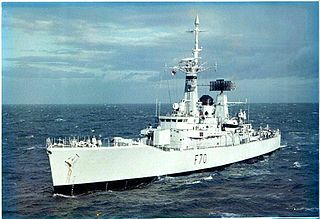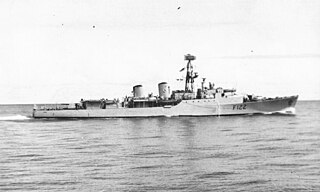| 1st Frigate Squadron | |
|---|---|
| Active | November 1972 – December 2001 |
| Country | |
| Branch | |
| Size | Squadron |
| Commanders | |
| First | Captain Geoffrey C. Lloyd |
| Last | Captain Philip A. Jones |
The 1st Frigate Squadron was a naval unit of the Royal Navy from 1972 to 2001.
| 1st Frigate Squadron | |
|---|---|
| Active | November 1972 – December 2001 |
| Country | |
| Branch | |
| Size | Squadron |
| Commanders | |
| First | Captain Geoffrey C. Lloyd |
| Last | Captain Philip A. Jones |
The 1st Frigate Squadron was a naval unit of the Royal Navy from 1972 to 2001.
During its existence, the squadron included Leander-class and Type 22 frigates. Ships from the squadron participated in the Cod Wars, the Silver Jubilee Fleet Review, the Armilla Patrol and the Falklands War. The squadron was disbanded in 2001.
At the Silver Jubilee Fleet Review, 24–29 June 1977, 1st Frigate Squadron comprised: [1]
| Commander | Ship | Dates |
|---|---|---|
| Captain Geoffrey C. Lloyd | HMS Charybdis | November 1972-December 1973 |
| Captain John A.F. Lawson | HMS Charybdis | December 1973-April 1975 |
| Captain D. Conrad Jenkin | HMS Galatea | April–October 1975 |
| Captain William S. Gueterbock | HMS Galatea | October 1975-March 1977 |
| Captain David B. Nolan | HMS Galatea | March 1977-August 1978 |
| Captain Anthony R. Barnden | HMS Galatea | August 1978-November 1979 |
| Captain Robin I. T. Hogg | HMS Galatea | November 1979-January 1981 |
| Captain Timothy M. Bevan | HMS Ajax | January–April 1981 |
| Captain Jeremy M. Porter | HMS Ajax | April 1981-May 1983 |
| Captain Peter C. Abbott | HMS Ajax | May 1983-December 1984 |
| Captain John F.S. Trinder | HMS Ajax/HMS Euryalus | December 1984 – 1986 |
| Captain David M. Jeffreys | HMS Euryalus | 1986-June 1987 |
| Captain Geoffrey A. Eades | HMS Beaver | June 1987-March 1988 |
| Captain Andrew B. Gough | HMS Beaver | March–August 1988 |
| Captain Anthony Morton | HMS Beaver | August 1988 – 1990 |
| Captain Roger C. Lane-Nott | HMS Coventry | March 1990 – 1991 |
| Captain Stephen E. Saunders | HMS Coventry | 1991-1993 |
| Captain Christopher D. Stanford | HMS Coventry | 1993-1994 |
| Captain Thomas Morton | HMS Coventry | 1994-1996 |
| Captain David A. Lewis | HMS Boxer | 1996-1997 |
| Captain Richard J. Ibbotson | HMS Beaver/HMS Boxer | 1997-December 1999 |
| Captain Philip A. Jones | HMS Coventry | December 1999 – 2001 |

HMS Ocelot (S17) is an Oberon-class diesel-electric submarine which was operated by the Royal Navy.

HMS Galatea (F18) was a Leander-class frigate of the Royal Navy. She was built by Swan Hunter & Wigham on the Tyne. She was launched on 23 May 1963 and commissioned on 25 April 1964 and was the eighth ship of the Royal Navy to bear the name.

HMS Charybdis (F75) was a Leander-class frigate of the Royal Navy (RN). She was built by the Harland & Wolff company of Belfast, and was the last ship to be built there for British naval forces until RFA Fort Victoria of the Royal Fleet Auxiliary, was launched in 1990. Charybdis was launched on 28 February 1968 and commissioned on 2 June 1969. Her nickname was "Cherry B".

HMS Euryalus (F15) was a Leander-class frigate of the Royal Navy (RN). Like the rest of the class, Euryalus was named after a figure of mythology. Euryalus was built by Scotts Shipbuilders of Greenock. Euryalus was launched on 6 June 1963, and commissioned on 16 September 1964.

HMS Cleopatra (F28) was a Leander-class frigate of the Royal Navy (RN). Cleopatra was built at HMNB Devonport. She was launched on 21 March 1964, commissioned on 1 March 1966 and decommissioned on 31 January 1992.

HMS Naiad (F39) was a Leander-class frigate of the Royal Navy (RN). Like the rest of the class, Naiad was named after a figure or figure of mythology, in this case, the Naiads of Greek mythology. Naiad was built by Yarrow Shipbuilders of Scotstoun. She was launched on 4 November 1963 and commissioned on 15 March 1965.

HMS Hermione (F58) was a Leander-class frigate of the Royal Navy (RN). She was, like the rest of her class, named after a figure of mythology. Hermione was built by Alexander Stephen and Sons, though she was completed by Yarrow Shipbuilders. She was launched on 26 April 1967 and commissioned on 11 July 1969.

HMS Apollo was a batch 3B broadbeam Leander-class frigate of the Royal Navy. She was, like the rest of the class, named after a figure of mythology. Apollo was built by Yarrow Shipbuilders of Scotstoun. She was launched on 15 October 1970 and commissioned on 28 May 1972, making her the penultimate Leander.

HMS Ariadne was a Leander-class frigate of the Royal Navy. She was launched in 1971, was sold to Chile in 1992 and sunk as a target hulk in 2004.

HMS Jupiter (F60) was a Batch 3 Leander-class frigate of the Royal Navy (RN). She was, like the rest of the class, named after a figure of mythology. Built by Yarrow Shipbuilders of Scotstoun, she was launched on 4 September 1967 and commissioned on 9 August 1969.
HMS Phoebe (F42) was a Leander-class frigate of the Royal Navy (RN). She was, like the rest of her class, named after a figure of mythology. Built by Alexander Stephen and Sons on the River Clyde, she was launched on 19 December 1964 and commissioned on 15 May 1966.

HMS Tartar (F133) was a Tribal-class frigate of the Royal Navy (RN). She was named after the Tartar people, most of whom were located in Asia and Eastern Europe. She was sold to the Indonesian Navy in 1984 as KRI Hasanuddin (333).

HMS Gurkha (F122) was a Tribal-class frigate of the Royal Navy. She was named after an ethnic group located in Nepal, and who continue to serve in the British Army. She was sold to the Indonesian Navy in 1984 and renamed KRI Wilhelmus Zakarias Yohannes (332).

The Battle of Jutland was fought on 31 May and 1 June 1916, in the waters of the North Sea, between forces of the Royal Navy Grand Fleet and Imperial German Navy High Seas Fleet. The battle involved 250 warships, and, in terms of combined tonnage of vessels engaged, was the largest naval battle in history.

HMS Hardy was an anti-submarine warfare frigate of the Blackwood class or Type 14. She was named after Thomas Masterman Hardy, Captain of HMS Victory at Trafalgar. Hardy was the first Type 14 frigate built, completed on 8 December 1955, by Yarrow Shipbuilders.
The 2nd Frigate Squadron was an administrative unit of the Royal Navy from 1947 to 2002.

HMS Dundas was a Blackwood-class anti-submarine warfare frigate of the Royal Navy.

HMS Salisbury was a Salisbury-class or Type 61 aircraft direction frigate of the British Royal Navy. Completed in the late 1950s, Salisbury served through the 1960s and 1970s, participating in the Beira Patrol, blockading against Rhodesia and the confrontation with Iceland over fishing rights that was known as the Cod Wars. Salisbury became a harbour training ship in 1980, before being sunk as a target in 1985.
The 5th Frigate Squadron was an administrative unit of the Royal Navy from 1946 to 1980.
The 6th Frigate Squadron was an administrative unit of the Royal Navy from 1950 to 2002.